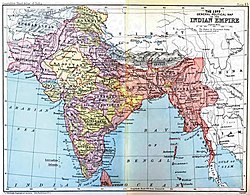Non-regulation province

Imperial entities of India
|
|
| Dutch India | 1605–1825 |
|---|---|
| Danish India | 1620–1869 |
| French India | 1769–1954 |
|
|
|
| Casa da Índia | 1434–1833 |
| Portuguese East India Company | 1628–1633 |
|
British India
(1612–1947) |
|
| East India Company | 1612–1757 |
| Company rule in India | 1757–1858 |
| British Raj | 1858–1947 |
| British rule in Burma | 1824–1948 |
| Princely states | 1721–1949 |
| Partition of India |
1947
|
|
|
|
Provinces of India, earlier Presidencies of British India and still earlier, Presidency towns, were the administrative divisions of British governance in the subcontinent. Collectively, they were called British India. In one form or other they existed between 1612 and 1947, conventionally divided into three historical periods.
In 1608, the English East India Company established a settlement at Surat (now in the state of Gujarat), and this became the company's first headquarters town. It was followed in 1611 by a permanent factory at Machilipatnam on the Coromandel Coast, and in 1612 the company joined other already established in Bengal. However, following the decline of the Mughal Empire in 1707 by the hands of the Marathas and after the East India Company's victory at the Battle of Plassey in 1757 and Battle of Buxar, both in Bengal 1764, the Company gradually began to formally expand its dominions and collectively call the area India. By the mid-19th century, and after the three Anglo-Maratha Wars the East India Company had become the paramount political and military power in South Asia, its territory held in trust for the British Crown.
Company rule in Bengal, however, ended with the Government of India Act 1858 following the events of the Bengal Rebellion of 1857. From then known as British India, it was thereafter directly ruled by the British Crown as a colonial possession of the , and India was officially known after 1876 as the British Indian Empire. India was divided into British India, regions that were directly administered by the British, with Acts established and passed in British Parliament, and the Princely States, that were ruled by local rulers of different ethnic backgrounds. These rulers were allowed a measure of internal autonomy in exchange for British suzerainty. British India constituted a significant portion of India both in area and population; in 1910, for example, it covered approximately 54% of the area and included over 77% of the population. In addition, there were Portuguese and French exclaves in India. Independence from British rule was achieved in 1947 with the formation of two nations, the Dominions of India and Pakistan, the latter also including East Bengal, present-day Bangladesh.
...
Wikipedia
